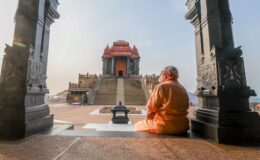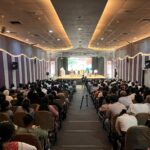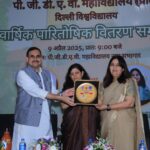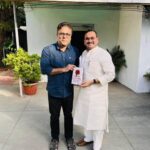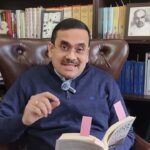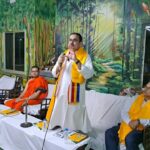Bharata Shakti
- By : Anirban Ganguly
- Category : Articles
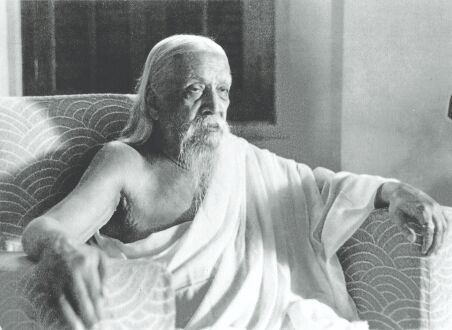
As his 150th birth anniversary draws closer, the vision of India that was conceptualised by Sri Aurobindo is finally finding irrefutable realisation
In the second year of India’s independence, in December 1948, Sri Aurobindo, in a rare gesture, accepted the conferment on him of the Cattamanchi Ramalinga Reddy (CR) National Prize for ’eminent merit in humanities.’ While announcing the prize, CRReddy, himself a pre-eminent educationist of his era, movingly observed thus of Sri Aurobindo and the reason for conferring on him the award, “our object in founding the National Prize was to bring about the association between the members of the University [Andhra University] and the inspiring personalities of contemporary India, they that make history and will live in history as permanent lights that lead us through the encircling gloom. If that was our object, we have reached the summit of realisation today by the kindly acceptance of this offering of ours by Sri Aurobindo. We are not awarding; we are making an offering…”
Indeed, nearly 75 years after that conferment, as we move towards the sesquicentennial of his birth on August 15, 2021, which is also the 75th anniversary of India’s independence, Sri Aurobindo remains among one of the most active and attractive permanent lights that leads India’s destiny towards, what he had often spoken of and envisaged — becoming a Visva Guru. As we near his 150th birth anniversary, the India of Sri Aurobindo’s hopes is assuming shape and pursuing an irreversible direction.
In his message given during the prize acceptance, in a sense his last public message, in December 1948, Sri Aurobindo had sounded a note of caution for newly independent India. He said, “It would be a tragic irony of fate if India were to throw away her spiritual heritage at the very moment when in the rest of the world there is more and more a turning towards her for spiritual help and saving light…” In his essay ‘Is India Civilised’ written between December 1918 and February 1919, a hundred years ago, Sri Aurobindo spoke of the need for an ‘active self-defence’, civilisationally and culturally, “The culture which gives up”, he wrote, “its living separateness, the civilisation which neglects active self-defence will be swallowed up and the nation which lived by it will lose its soul and perish.” For Sri Aurobindo, “each nation is a Shakti…and lives by the principle which it embodies” and India, “is the Bharata Shakti, the living energy of a great spiritual conception, and fidelity to it is the very principle of her existence. For by its virtue alone she has been one of the immortal nations…” It was this alone which, Sri Aurobindo observed, “has been the secret of her amazing persistence and perpetual force of survival and revival.”
Sri Aurobindo and some of his illustrious predecessors and as well as his contemporaries emphasised on the need to perceive and perpetuate the deeper and more fundamental essence of our national existence. As one of the most astute and deep-seeing philosophers of our times, Ram Swarup lyrically described it, “they taught that India was more than a geographical entity, that it was a holy land, a sacred trust, a spiritual idea, a power of the spirit, even a deity; they taught that India was rising for the truth it embodied, for recovering its ‘svabhava’.” Thus “great cultural thinkers who were also great ‘sadhakas’ spoke of their cultural heritage, about the Vedas, about Sanatana dharma, with pride…” Sri Aurobindo, was also the first one, to impart this spiritual dimension to our struggle for freedom. This layer became the sustaining dimension, the underlying flow of this struggle. The need to awaken our collective-self to our essential civilizational and cultural core became the leitmotif of this generation of thinkers, philosophers and national awakeners, starting with Sri Ramakrishna, Vivekananda, Dayananda and Bankim.
The danger of throwing away India’s spiritual heritage presented itself and persisted in the decades following independence, when, a cultural-spiritual self-renewal and self-rejuvenation was despised, opposed, marginalised and arrested, especially by a political class which did not believe in it, had no patience or reverence for the faith of India’s majority and created a system of the state in which an imposed secularism essentially meant being anti-civilisational-India. The idea of India’s spiritual heritage playing a principal role in shaping free India’s worldview and global engagement, or in the shaping of her internal order was downplayed and rejected. The idea of India being the Bharata Shakti was dumped as mere ideological and dated positioning and the entire strategy of an active self-defence was given up. Girilal Jain, one of the most perceptive socio-political observers of India argued, that it was “our failure to view ourselves as a civilisation and to formulate the tasks for our state accordingly that lies behind many of the problems we face.”
Prolific intellectual giant, a seer when it came to India’s sacred and cultural dimensions DV Gundappa (DVG) argued that the “root of culture is the sense of elevation we experience in the presence of the sacred.” This sense of elevation in the presence of the sacred, took a battering in our political and educational system after independence. As a colonised people, our knowledge systems and expressions were either crushed or deliberately misinterpreted, after we achieved political freedom. We had the scope for re-integrating these in the modern context but we persisted in ignoring that line and necessity. A certain political class enjoined that the sense of sacred should give rise to repulsion which would be a true tribute to and worship of ‘secularism.’
Post-independent India’s education system was so designed and imposed that far from imparting a sense of elevation, it had no central place for India’s cultural essentials. The leaders of this deconstruction were primarily Marxists ideologues who often influenced the political direction and were allowed to control the levers of academia, of research and of narrative building. As Ram Swarup, described them and their mission of opposing India’s cultural self-expression, “Communists opposed India’s first struggle for freedom in the thirties and forties; they are also opposing its second struggle for cultural and religious self-articulation which is being waged in the present times.” Communists and Marxists found as their allies separatists and ‘Hindu self-haters.’ The likes of Sri Aurobindo, thus, had no place in the making of free India. Customary obeisance and cursory reverence were what their legacy received, while an influential class of deracinated intellectuals and ideologues, driven by an artificial ideology, ensured that he, like a number of his predecessors and contemporaries, were driven out of our educational and policymaking systems.
Free India’s leaders were at liberty to recognise her civilisational dimension, but for decades they chose not to do it. That is now being conclusively reversed, especially since the summer of 2014, when India chose to liberate herself a second time from the grip of cultural apathy and a tradition of Hindu hating secularism. The editorial of a journal published from then Bombay, whose editorials were said to be whetted and passed by Sri Aurobindo, had argued in the early months of the Republic thus, “India’s secular constitution does not run counter to a belief in God by the majority of the nation who are religious, nor does it run counter to the Government’s being Hindu in essential religion, for if the majority of India follow the Hindu religion what else should we expect a representative Government to do? … A secular state which is indifferent to religion and yet tries to be based on true ideals is a contradiction in terms!” it noted. The Ram Mandir Bhumi Pujan, Prime Minister Modi’s historic address on the occasion, his pointing out that the temple will become “a modern symbol of India’s traditions, devotion and national sentiment”, his referring to the ideals symbolised by Sri Ram and their essence in re-imagining and realising the fundamentals of the Ram Rajya discourse, is proof that self-negating secularism has finally been conclusively challenged. That India is ruled by those who have reverence for the rishis and India’s traditions, is another unmistakable proof of that.
As we near his 150th birth anniversary, we see a number of Sri Aurobindo’s hopes being visibly realised. His concern for resolving the Kashmir ‘imbroglio’, has seen one decisive resolution through the abrogation of Article 370, it is now an integrated India from the Himalayas to the Indian Ocean. The recovery of portions of India is now the next hope. Sri Aurobindo’s concern for Hindu refugees, post-partition, victims of the ideology of an Islamic state who were compelled to forsake their homes and to flee to India from the neighbourhood, especially from East Bengal/Pakistan, has also seen decisive action with the passing of the historic CAA. The National Education Policy 2020, its vision of new education, its emphasis on the core of an education that is inspired by India’s cultural and civilisational ethos, is a near-exact reflection of Sri Aurobindo’s vision of national education for India. He would have certainly been welcoming of it. Sri Aurobindo’s hope of India’s knowledge systems and spiritual tradition penetrating with greater rigour the global arena is being fulfilled in a number of ways. The International Yoga Day and India’s leadership of it is one of the most evident examples of the realisation of that hope. Sri Aurobindo’s hope for India to be a more pragmatic and proactive power, siding with democracies, spreading values and at the same time deftly protecting her interests, his hope for a reformed UNSC, for a greater international role for India, is now seeing gradual and persistent realisation. His warnings on Pakistan have repeatedly come true. His hopes that India would always adopt a strong line with this nation — he was loath to even call Pakistan as a ‘nation’ — which was created through, as he termed it, “force” and “fraud”, is seeing fruition.
Sri Aurobindo’s vision for India’s self-reliance, is seeing a new direction and articulation through the movement of an Aatma Nirbhar Bharat. The stand that both our material as well as spiritual bases need strengthening is seeing expression in our collective action and discourse. India’s aspirations and Sri Aurobindo’s hopes of a free India is seeing a blending and a distinct harmonisation. The awakening of the ‘Bharata Shakti’ is once more visible, is being acknowledged and is now an inexorable process.
A century ago Sri Aurobindo had spoken of a “Yuga – Sandhya”, a morning and not an evening twilight, which he saw ushering in a new era of self-awakening for India. A hundred years after that and a hundred and fifty years after his birth, the India of his dreams, of his hopes and his meditations is taking shape. From a morning-twilight, we are moving towards a new morning of our collective journey and civilisational self-realisation.



